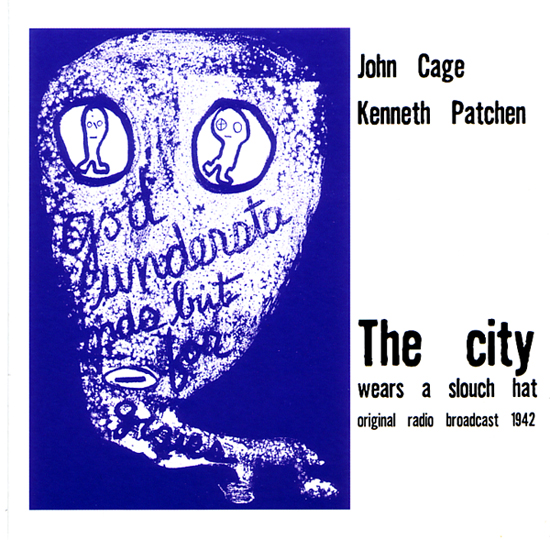The city wears a slouch hat 
“Just feel that good clean power surging in from the dark…Ah, but listen to her! She’s driving in, she knows what she wants, there’s no hero or devil on earth that can talk back to her…Come on in, girl!” The man talks over his beloved sea to “The Voice”; both having isolated themselves out there, away from the City and its people. This is one of my favorite lines from “The city wears a slouch hat”, a radio play written by Kenneth Patchen with a score by John Cage. It was broadcast on May 31, 1942 by WBBM radio station (Columbia Broadcasting System in Chicago) and is the Voice’s surreal journey through the City, culminating in a message for humanity in a time of World War.

“The city wears a slouch hat”, a radio play written by Kenneth Patchen with a score by John Cage. Cover art by Patchen.
The backstory here is almost more interesting that the radio play itself. From James Pritchett:
The city wears a slouch hat is a piece with a history that begs to be told, the kind of story that biographical movies are made of: a story of opportunities discovered and lost; of ambition, success and failure; of grand dreams and their swift reduction to the modest proportions demanded by reality. It is a story about a young composer with a fresh idea and his encounter with The Establishment; it recounts his brush with fame and money, but leaves him a poor artist alone in the big city. When I describe it in this manner, it seems almost too novelistic to be true. But the truth is that the piece came at a critical juncture in Cage’s life, and its failure — and The city wears a slouch hat was mostly a failure — permanently affected his work. The John Cage of the Sonatas and interludes, and 4′33′’ would not have existed had this piece been a success.
Further:
Cage’s idea for The city wears a slouch hat came straight from his vision of the technological future of music. He would write a score exclusively for sound effects — “to use them not as effects, but as sounds, that is, as musical instruments.” Patchen’s script accomodated this vision with its liberal use of sonic imagery. Every scene in the play has some reference to the aural imagery surrounding the characters: music, street noises, telephones, ocean waves. Indeed, the main character of the play is simply “The Voice”, and his magical freedom of movement throughout the play suggests the permation of space by sound. The sweep of the action around the city, up to the sky, and out to the sea could best be put across to an audience through the manipulation of sound. When told by the sound effects engineer that “anything was possible,” Cage let his dreams take over: “I wrote 250 pages of score for instruments, the timbre, loudness, and relative pitch of which I described, but the existence of which I only guessed.” He composed the sounds of his imagination, confident that the technical know-how of the radio sound engineers could turn them into reality.
The 250-page score was as far as the dream went. When Cage, a mere week before the performance, delivered his score to the station, he was told that it was impossible to play. No doubt the engineer, in telling him that anything was possible, was not counting on the fantastic imagination of a composer devoted to musical experimentation. The visions that Cage had created in his mind — of a sound effects score, of the instruments that would play it, of the Center for Experimental Music that would result — these were all built on nothing more than a misunderstanding; when he arrived at the radio station they all collapsed. Cage must have been crushed. However, consummate professional that he was, he immediately began work on a substitute score, one more modest in means and using only percussion instruments, recordings, and amplified “small sounds.” Working around the clock he was able in only one week to write the score, copy it, and rehearse it with the players.
The Voice’s encounters on his journey reveal - at least to me - his ennui. He exercises the power of suggestion on weak minds, and prescience in this cruel example:
A choice selection, reminding me of Ed Wynn (the Mad Hatter’s voice in Disney’s “Alice in Wonderland”):
A slice of the Voice’s message for mankind (relevant in any context and especially moving considering the context in which it was written - WWII):
I found and purchased the original broadcast of “The city wears a slouch hat” through the Cortical Foundation. Their mission seems noble and the oddities in the organ of corti CD’s and LP’s catalog are worth a browse.













